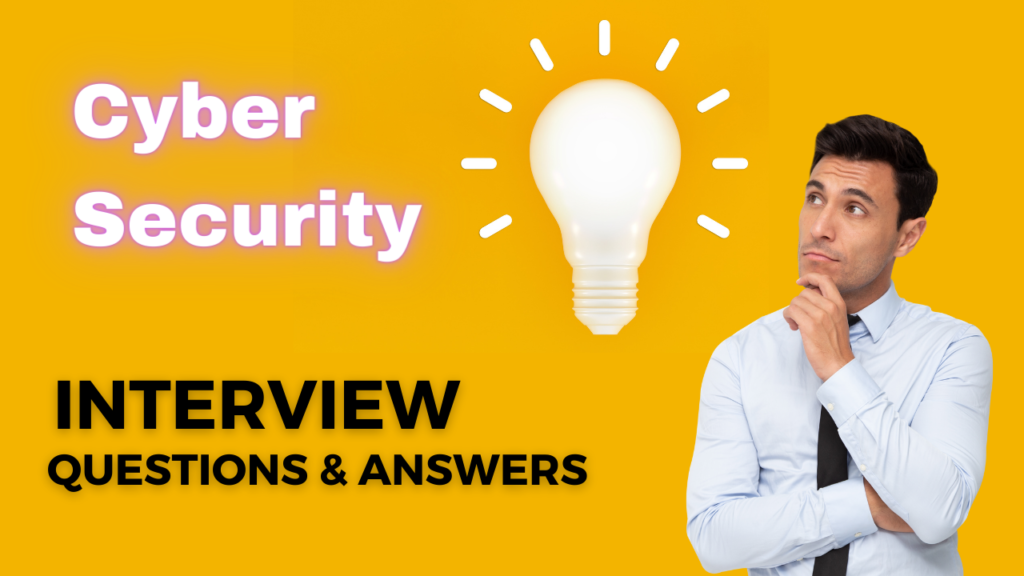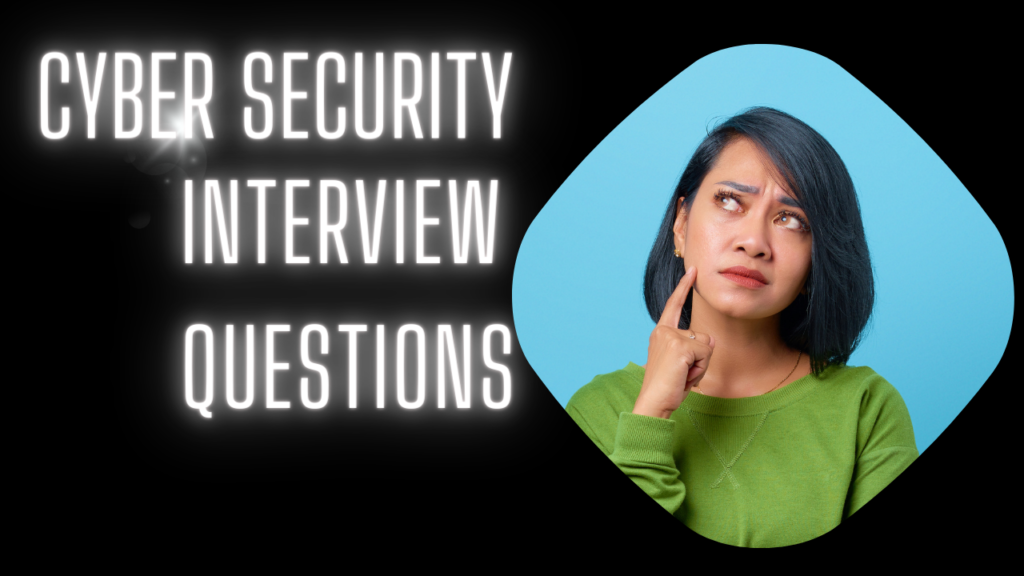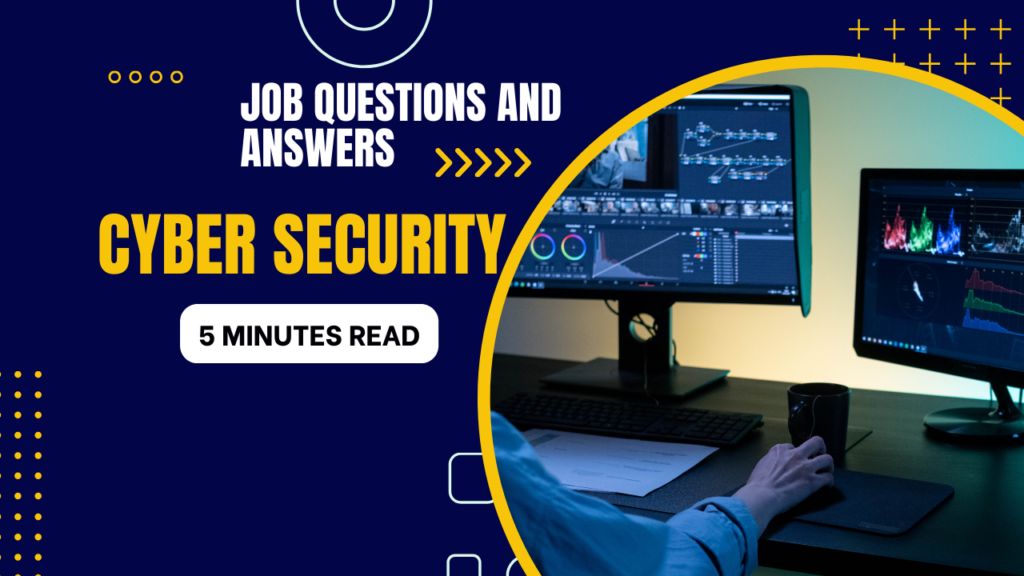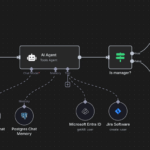Table of Contents

Introduction: about cyber security interview questions
Getting ready for a cyber security interview questions might feel a bit like solving a puzzle. Every question is like a piece of the puzzle, testing how well you know about keeping digital things safe and how smartly you can solve problems. It’s not just about knowing technical stuff; they also want to see if you can think carefully and quickly. Think of this blog post as your guide to understanding the basics of cybersecurity, figuring out specific areas you need to know, and learning how to talk about it during the interview.
By the end, you’ll not only understand the important stuff about cybersecurity but also know how to share your knowledge and excitement for keeping our digital world secure. Get ready to open the doors to a cool career in cybersecurity!
Securing a job in cybersecurity requires not only technical prowess but also the ability to articulate your knowledge and problem-solving skills during an interview. In this blog post, we’ll walk you through a step-by-step guide, covering common questions that often arise in cybersecurity job interviews. Whether you’re a recent graduate entering the field or a seasoned professional looking to advance your career, these questions and answers will help you prepare for the challenges that come your way.

Step 1: the Basics for cyber security interview questions
Q1: What is cybersecurity, and why is it important?
A: Cybersecurity is the practice of protecting computer systems, networks, and data from theft, damage, or unauthorized access. It’s crucial because as our reliance on technology grows, so does the risk of cyber threats. Effective cybersecurity safeguards sensitive information and ensures the smooth functioning of digital systems.
Q2: Can you explain the difference between encryption and hashing?
A: Encryption and hashing are both methods of protecting data, but they serve different purposes. Encryption is reversible and is used to protect data in transit, ensuring that only authorized parties can understand it. Hashing, on the other hand, is a one-way process and is primarily used for data integrity verification. It generates a fixed-size string of characters, known as a hash, which represents the original data.
Step 2: Network and Application Security
Q3: How do you defend against a DDoS (Distributed Denial of Service) attack?
A: Defending against DDoS attacks involves implementing measures to absorb or mitigate the impact of a flood of incoming traffic. This can include deploying firewalls, load balancers, and content delivery networks (CDNs). Additionally, having a DDoS response plan in place helps to minimize downtime and ensure a swift recovery.
Q4: What are the OWASP Top 10 vulnerabilities, and how can they be mitigated?
A: The OWASP Top 10 is a list of the most critical web application security risks. It includes issues like injection attacks, cross-site scripting (XSS), and security misconfigurations. Mitigation strategies involve secure coding practices, input validation, and regular security audits to identify and address vulnerabilities.
Step 3: Identity and Access Management (IAM) and Incident Response
Q5: Explain the concept of multi-factor authentication (MFA).
A: Multi-factor authentication adds an extra layer of security beyond just a username and password. It typically involves something you know (password), something you have (a mobile device or token), and something you are (biometrics). MFA significantly enhances the security of an account by requiring multiple forms of verification.
Q6: How would you approach an incident response plan?
A: Developing an incident response plan involves preparation, detection, containment, eradication, recovery, and lessons learned. It’s essential to identify potential risks, establish communication protocols, and regularly test the plan through simulated incidents. The goal is to minimize the impact of security incidents and ensure a swift and effective response.
Step 4: Soft Skills and Ethics
Q7: Why is effective communication important in cybersecurity?
A: Effective communication is crucial in cybersecurity because professionals need to convey complex technical information to various stakeholders, including non-technical individuals. Clear communication helps in articulating security risks, explaining mitigation strategies, and fostering a collaborative approach to cybersecurity within an organization.
Q8: Can you discuss the ethical considerations in ethical hacking?
A: Ethical hacking involves authorized testing of systems to identify vulnerabilities. Ethical hackers must operate within legal and ethical boundaries, obtaining proper authorization before conducting tests. It’s essential to respect privacy, follow responsible disclosure practices, and prioritize the security and well-being of the systems being tested.
Step 5: Security Governance and Compliance
Q9: What is the purpose of penetration testing, and how does it contribute to cybersecurity?
A: Penetration testing, or ethical hacking, simulates cyberattacks to identify vulnerabilities in a system. Its purpose is to assess the security posture of an organization, discover potential weaknesses, and provide actionable recommendations for improvement. By conducting penetration tests regularly, organizations can proactively strengthen their defenses.
Q10: How does GDPR impact cybersecurity, and what measures should a company take to ensure compliance?
A: The General Data Protection Regulation (GDPR) is a set of regulations designed to protect the privacy and personal data of European Union citizens. To ensure compliance, companies need to implement robust data protection measures, obtain explicit consent for data processing, appoint a Data Protection Officer (DPO), and promptly report data breaches to regulatory authorities.
Step 6: Emerging Technologies
Q11: What are the security challenges associated with the Internet of Things (IoT), and how can they be addressed?
A: IoT devices introduce new security challenges due to their interconnected nature. Issues such as weak authentication, lack of encryption, and device vulnerabilities can pose risks. Addressing these challenges involves implementing strong authentication mechanisms, encrypting communication, and regularly updating device firmware to patch vulnerabilities.
Q12: How do you secure a cloud infrastructure, and what are the key considerations for cloud security?
A: Securing a cloud infrastructure involves a shared responsibility model between the cloud service provider and the customer. Key considerations include configuring access controls, encrypting data in transit and at rest, monitoring for unusual activities, and ensuring compliance with industry regulations.
Step 7: Professional Development and Industry Knowledge
Q13: How do you stay updated on the latest cybersecurity threats and trends?
A: Staying informed in cybersecurity is crucial. I regularly follow reputable cybersecurity blogs, participate in forums and conferences, and engage in continuous learning through online courses and certifications. Being part of professional networks allows me to exchange knowledge and insights with other cybersecurity professionals.
Q14: Can you explain the concept of “zero trust” in cybersecurity, and how is it implemented?
A: Zero trust is a security model that assumes no trust, even within an organization’s network. It requires strict verification for anyone trying to access resources, regardless of their location. Implementing zero trust involves practices like micro-segmentation, least privilege access, continuous authentication, and thorough monitoring of network activities.
Step 8: Incident Handling and Response Scenarios
Q15: Walk me through the steps you would take during a suspected data breach incident.
A: In the event of a suspected data breach, the first step is to activate the incident response plan. This includes identifying the affected systems, containing the breach, preserving evidence, notifying relevant stakeholders, and cooperating with law enforcement if necessary. Post-incident, a thorough analysis is conducted to understand the root cause and prevent future occurrences.
Q16: How do you differentiate between a false positive and a true positive in security alerts?
A: Distinguishing between false positives and true positives is crucial to avoid unnecessary panic or overlooking real threats. A false positive occurs when an alert incorrectly indicates a security incident, while a true positive signifies a genuine security threat. Analyzing contextual information, conducting thorough investigations, and utilizing threat intelligence help in making accurate determinations.
Summary
cyber security interview questions & answers :
To succeed in a cybersecurity job interview, a multifaceted approach is essential. Firstly, ensure a solid understanding of the foundational concepts, including the basics of cybersecurity, network security, and application security. Articulate your knowledge clearly, providing concise yet comprehensive answers to technical questions. Secondly, emphasize the practical application of your skills,
showcasing hands-on experience and detailing specific projects or challenges you’ve overcome. Employers often seek candidates who not only understand the theory but can apply it effectively in real-world scenarios.
Moreover, soft skills play a pivotal role. Effective communication, both technical and non-technical, is crucial in conveying complex concepts to diverse stakeholders. Showcase your ability to work collaboratively, as cybersecurity is a team effort. Additionally, demonstrates ethical considerations, especially in roles involving penetration testing or ethical hacking.
Employers value professionals who operate within legal and ethical boundaries. By combining technical proficiency, practical application, and strong soft skills, you’ll position yourself as a well-rounded candidate ready to tackle the dynamic challenges of a cybersecurity role.
To read more cyber security interview questions visit blog sections and to contact us please visit SGK








